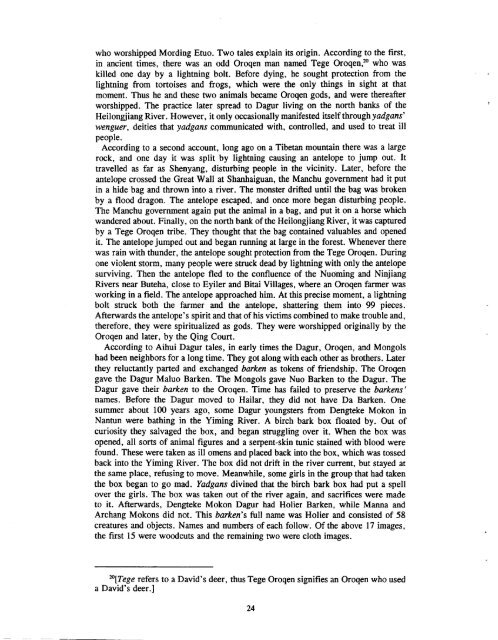China's Dagur Minority - Sino-Platonic Papers
China's Dagur Minority - Sino-Platonic Papers
China's Dagur Minority - Sino-Platonic Papers
You also want an ePaper? Increase the reach of your titles
YUMPU automatically turns print PDFs into web optimized ePapers that Google loves.
who worshipped Mording Etuo. Two tales explain its origin. According to the first,in ancient times, there was an odd Oroqen man named Tege Or~qen,~ who waskilled one day by a lightning bolt. Before dying, he sought protection from thelightning from tortoises and frogs, which were the only things in sight at thatmoment. Thus he and these two animals became Oroqen gods, and were thereafterworshipped. The practice later spread to <strong>Dagur</strong> living on the north banks of theHeilongjiang River. However, it only occasionally manifested itself through yadgans'wenguer, deities that yadgaas communicated with, controlled, and used to treat illpeople.According to a second account, long ago on a Tibetan mountain there was a largerock, and one day it was split by lightning causing an antelope to jump out. Ittravelled as far as Shenyang, disturbing people in the vicinity. Later, before theantelope crossed the Great Wall at Shanhaiguan, the Manchu government had it putin a hide bag and thrown into a river. The monster drifted until the bag was brokenby a flood dragon. The antelope escaped, and once more began disturbing people.The Manchu government again put the animal in a bag, and put it on a horse whichwandered about. Finally, on the north bank of the Heilongjiang River, it was capturedby a Tege Oroqen tribe. They thought that the bag contained valuables and openedit. The antelope jumped out and began running at large in the forest. Whenever therewas rain with thunder, the antelope sought protection from the Tege Oroqen. Duringone violent storm, many people were struck dead by lightning with only the antelopesurviving. Then the antelope fled to the confluence of the Nuoming and NinjiangRivers near Buteha, close to Eyiler and Bitai Villages, where an Oroqen farmer wasworking in a field. The antelope approached him. At this precise moment, a lightningbolt struck both the farmer and the antelope, shattering them into 99 pieces.Afterwards the antelope's spirit and that of his victims combined to make trouble and,therefore, they were spiritualized as gods. They were worshipped originally by theOroqen and later, by the Qing Court.According to Aihui <strong>Dagur</strong> tales, in early times the <strong>Dagur</strong>, Oroqen, and Mongolshad been neighbors for a long time. They got along with each other as brothers. Laterthey reluctantly parted and exchanged barken as tokens of friendship. The Oroqengave the <strong>Dagur</strong> Maluo Barken. The Mongols gave Nuo Barken to the <strong>Dagur</strong>. The<strong>Dagur</strong> gave their barken to the Oroqen. Time has failed to preserve the barkens'names. Before the <strong>Dagur</strong> moved to Hailar, they did not have Da Barken. Onesummer about 100 years ago, some <strong>Dagur</strong> youngsters from Dengteke Mokon inNantun were bathing in the Yirhing River. A birch bark box floated by. Out ofcuriosity they salvaged the box, and began struggling over it. When the box wasopened, all sorts of animal figures and a serpent-skin tunic stained with blood werefound. These were taken as ill omens and placed back into the box, which was tossedback into the Yiming River. The box did not drift in the river current, but stayed atthe same place, refusing to move. Meanwhile, some girls in the group that had takenthe box began to go mad. Yadgans divined that the birch bark box had put a spellover the girls. The box was taken out of the river again, and sacrifices were madeto it. Afterwards, Dengteke Mokon <strong>Dagur</strong> had Holier Barken, while Manna andArchang Mokons did not. This barken's full name was Holier and consisted of 58creatures and objects. Names and numbers of each follow. Of the above 17 images,the first 15 were woodcuts and the remaining two were cloth images.20[Tege refers to a David's deer, thus Tege Oroqen signifies an Oroqen who useda David's deer.]24
















